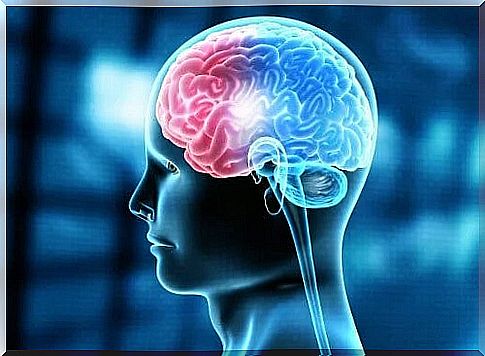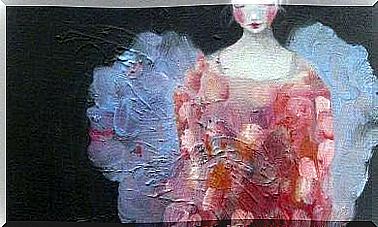The Gerstmann Syndrome: I Can No Longer Recognize My Fingers

Gerstmann syndrome is a rare neurological disease. The best-known fact about Gerstmann syndrome is also the most striking characteristic of it: the patient can no longer recognize his fingers. However, behind this symptom is a much more complex and acquired disease. This means that symptoms appear after being injured or suffering from an illness.
The disease was named after the Austrian neurologist and psychiatrist Dr. Josef Gerstmann, who at the time of discovery in 1924 was still working as an assistant in the neurology department at the University of Vienna. At the time, he described a number of symptoms in a woman who had suffered a stroke. From then on, the disease bore his name. These include finger and toe agnosia, agraphia, and acalculia.

The causes of Gerstmann syndrome
First of all, we should note that most known cases develop from a vascular problem. Such a problem also appears to be the main cause of Gerstmann syndrome. Typically, with this syndrome, the patient has difficulty recognizing or moving their toes and fingers. The usual symptoms are:
- First the finger and toe agnosia. It is not possible for the patient to recognize their own toes and fingers. He acts like he has no fingers.
- Agraphy. Along with the first symptom on the list, patients lose the ability to express themselves in writing.
- Acalculia. Patients suffering from Gerstmann syndrome lose the ability to solve simple math problems.
- Finally disorientation. The patient is unable to orient himself correctly in space and does not confuse or recognize the difference between right and left.
Lesion of the brain tissue in Gerstmann syndrome
In 1930, Dr. Josef Gerstmann finally described the syndrome named after him after studying the injuries of his patients. He found that most of them had sustained damage in part of the parietal lobe, the inferior parietal lobule – more precisely in the angular gyrus.
In the anatomy of the brain, the representations of body regions in the parietal lobe are understood as sensory or motor homunculus – as described in the Jasper-Penfield scheme. In the parietal lobe there is a certain area that specializes in the fingers. This area is much larger in proportion to the rest of the body. This is due to the importance of the hands and the amount of nerve endings that are in the hands.
Angular rotation
This brain region, which is particularly affected by Gerstmann syndrome, is located at the lower end of the parietal lobe. It is related to the conception of language in which a common code is assigned for visual and heard information.
Usually, patients with Gerstmann’s syndrome have vascular injuries in the left middle cerebral artery that runs around the angular gyrus.
Clinical features
We should therefore also make it clear that Gerstmann syndrome often only occurs incompletely. This means that the three main characteristics do not have to be present at the same time in order to make a diagnosis.
Often there are no signs of agraphia. Instead, semantic aphasia often occurs. This describes a defect in the understanding of logical-grammatical structures.
The Gerstmann syndrome nowadays
Since the Gerstmann syndrome was described for the first time almost a hundred years ago, many individual symptoms have been put up for debate in the context of scientific progress. Scientists are currently discussing the organic basis of the syndrome. They suggest other areas in the parietal lobe in the etiology of the syndrome, which denotes the causes of the development of a disease.
Most patients have lesions in the left parietal lobe. This half of the brain has the upper hand in most cases when it comes to right-handed people. Therefore, anomalies occur at the cortical level in areas of complex processing.
diagnosis
The medical disciplines that deal with the diagnosis of Gerstmann syndrome are neurology and neuropsychology. Suspected cases of this syndrome often arise when affected patients are asked to perform tasks involving finger and toe recognition.
On a neurological level, diagnosis begins with exploratory testing. Doctors will then confirm the diagnosis using magnetic resonance imaging (MRI) imaging. This procedure can be used to detect damaged tissue. Neuropsychology, in turn, is responsible for evaluating and assessing the restricted cognitive abilities through clinical observation.

treatment
According to various experts, there are different approaches to treating Gerstmann syndrome. In short, a combination of neurological and psychological therapy is necessary in all cases.
- Neurological treatment. This approach focuses on the organic damage that is treated using standardized procedures. It depends on whether the cause can be found in a vascular problem or whether there is a brain tumor.
- Neuropsychological treatment. This involves working on the cognitive functions that are affected by the injury. In addition, the procedure must be tailored to the patient and should encompass different specialties because the symptoms are variable.
- Psychological education. It is very important here to convey information and to create an awareness of the syndrome so that one can work on the underlying emotional aspects.
Finally, with the combination of neurological and neuropsychological treatment, doctors and specialists must focus on ensuring that the patients are functionally restored. The main focus should be on ensuring that the limbs function optimally again without individual fingers or toes falling out.
In principle, because of its peculiar characteristic features, Gerstmann syndrome has attracted the attention of researchers and specialists – although it rarely occurs in the normal population.
It is interesting to note that the correct functioning of the brain also depends on the correct functioning of the vascular system. Therefore, all activities that represent a risk factor for the cardiovascular system also endanger the nervous system at the same time.









